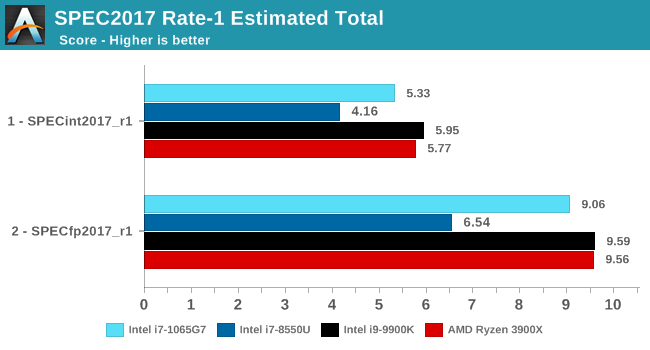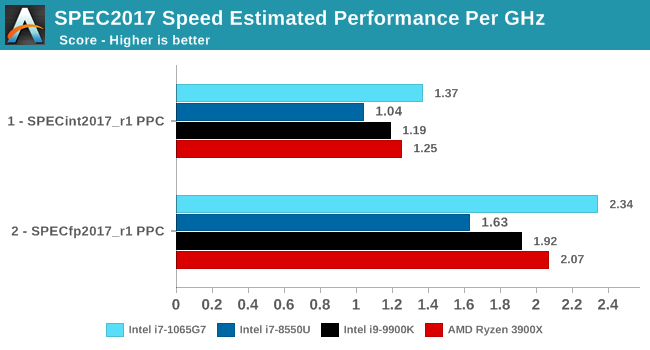The Ice Lake Benchmark Preview: Inside Intel's 10nm
by Dr. Ian Cutress on August 1, 2019 9:00 AM EST- Posted in
- CPUs
- Intel
- GPUs
- 10nm
- Core
- Ice Lake
- Cannon Lake
- Sunny Cove
- 10th Gen Core
Section by Andrei Frumusanu
SPEC2017 and SPEC2006 Results (15W)
SPEC2017 and SPEC2006 is a series of standardized tests used to probe the overall performance between different systems, different architectures, different microarchitectures, and setups. The code has to be compiled, and then the results can be submitted to an online database for comparsion. It covers a range of integer and floating point workloads, and can be very optimized for each CPU, so it is important to check how the benchmarks are being compiled and run.
We run the tests in a harness built through Windows Subsystem for Linux, developed by our own Andrei Frumusanu. WSL has some odd quirks, with one test not running due to a WSL fixed stack size, but for like-for-like testing is good enough. SPEC2006 is deprecated in favor of 2017, but remains an interesting comparison point in our data. Because our scores aren’t official submissions, as per SPEC guidelines we have to declare them as internal estimates from our part.
For compilers, we use LLVM both for C/C++ and Fortan tests, and for Fortran we’re using the Flang compiler. The rationale of using LLVM over GCC is better cross-platform comparisons to platforms that have only have LLVM support and future articles where we’ll investigate this aspect more. We’re not considering closed-sourced compilers such as MSVC or ICC.
clang version 8.0.0-svn350067-1~exp1+0~20181226174230.701~1.gbp6019f2 (trunk)
clang version 7.0.1 (ssh://git@github.com/flang-compiler/flang-driver.git
24bd54da5c41af04838bbe7b68f830840d47fc03)-Ofast -fomit-frame-pointer
-march=x86-64
-mtune=core-avx2
-mfma -mavx -mavx2
Our compiler flags are straightforward, with basic –Ofast and relevant ISA switches to allow for AVX2 instructions. Despite ICL supporting AVX-512, we have not currently implemented it, as it requires a much greater level of finesse with instruction packing. The best AVX-512 software uses hand-crafted intrinsics to provide the instructions, as per our 3PDM AVX-512 test later in the review.
For these comparisons, we will be picking out CPUs from across our dataset to provide context. Some of these might be higher power processors, it should be noted.
SPECint2006

Amongst SPECint2006, the one benchmark that really stands out beyond all the rest is the 473.astar. Here the new Sunny Cove core is showcasing some exceptional IPC gains, nearly doubling the performance over the 8550U even though it’s clocked 100MHz lower. The benchmark is extremely branch misprediction sensitive, and the only conclusion we can get to rationalise this increase is that the new branch predictors on Sunny Cove are doing an outstanding job and represent a massive improvement over Skylake.
456.hmmer and 464.h264ref are very execution bound and have the highest actual instructions per clock metrics in this suite. Here it’s very possible that Sunny Cove’s vastly increased out-of-order window is able to extract a lot more ILP out of the program and thus gain significant increases in IPC. It’s impressive that the 3.9GHz core here manages to match and outpace the 9900K’s 5GHz Skylake core.
Other benchmarks here which are limited by other µarch characteristics have various increases depending on the workload. Sunny Cove doubled L2 cache should certainly help with workloads like 403.gcc and others. However because we’re also memory latency limited on this platform the increases aren’t quite as large as we’d expect from a desktop variant of ICL.

In SPECfp2006, Sunny Cove’s wider out-of-order window can again be seen in tests such as 453.povray as the core is posting some impressive gains over the 8550U at similar clocks. 470.lbm is also instruction window as well as data store heavy – the core’s doubled store bandwidth here certainly helps it.

Overall in SPEC2006, the new i7-1065G7 beats a similarly clocked i7-8550U by a hefty 29% in the int suite and 34% in the fp suite. Of course this performance gap will be a lot smaller against 9th gen mobile H-parts at higher clocks, but these are also higher TDP products.
The 1065G7 comes quite close to the fastest desktop parts, however it’s likely it’ll need a desktop memory subsystem in order to catch up in total peak absolute performance.

Performance per clock increases on the new Sunny Cove architecture are outstandingly good. IPC increases against the mobile Skylake are 33 and 38% in the integer and fp suites, though we also have to keep in d mind these figures go beyond just the Sunny Cove architecture and also include improvements through the new LPDDR4X memory controllers.
Against a 9900K, although apples and oranges, we’re seeing 13% and 14% IPC increases. These figures likely would be higher on an eventual desktop Sunny Cove part.
SPEC2017



The SPEC2017 results look similar to the 2006 ones. Against the 8550U, we’re seeing grand performance uplifts, just shy of the best desktop processors.

Here the IPC increase also look extremely solid. In the SPECin2017 suite the Ice Lake part achieves a 14% increase over the 9900K, however we also see a very impressive 21% increase in the fp suite.
Overall in the 2017 suite, we’re seeing a 19% increase in IPC over the 9900K, which roughly matches Intel’s advertised metric of 18% IPC increase.










261 Comments
View All Comments
unclevagz - Thursday, August 1, 2019 - link
I am assuming that Ice lake-Us aren't all i7s, because that's what the first page table is listing.Also, when you have more time, would it be possible to put spec2k6/2k17 test results of other processors at 3.9ghz for a more direct IPC comparison? Not to mention it'd be nice to list results from mobile SoCs (A12, SD855 etc) just for reference as well.
Ryan Smith - Thursday, August 1, 2019 - link
Thanks!DanNeely - Thursday, August 1, 2019 - link
The first table of CPUs lists all the models as i7, not i7/5/3 as described in the article text.ToTTenTranz - Thursday, August 1, 2019 - link
Is it my impression or the 15-25W TDP switch is only affecting the CPU power budget while leaving the GPU intact?It's making no difference in gaming workloads except for the WoW benchmark, where at >200 FPS we're clearly looking at a CPU-limited scenario.
What's VRS? The Variable Rate Shading test from 3dmark? Could that somehow be CPU-limited too?
Ian Cutress - Thursday, August 1, 2019 - link
Correct on the CPU budget.For variable rate shading, see here: https://www.anandtech.com/show/14514/examining-int...
I'll update the article too
ToTTenTranz - Thursday, August 1, 2019 - link
Thanks for the response Ian.Did you ask them if this is something Intel will tweaking this further?
It seems that the 25W mode is leaving a lot of GPU performance on the table, and in GPU-intensive tasks they'd gain a lot more by keeping the CPU power budget intact while providing more headroom for higher clocks on the GPU.
This would be akin to what AMD is doing with mobile Raven Ridge and Picasso, but Intel has a major bandwidth advantage here.
Ian Cutress - Thursday, August 1, 2019 - link
I'm not sure how well the GPU clocks if you push the power. We haven't seen many Intel mobile IGPs go above 1100/1150 in quite a while. I wonder if there's a limit there, or simply Intel needed a minimum CPU performance and whatever was left went to the GPU.Lots of ways to slice it. Only Intel knows for sure.
eastcoast_pete - Thursday, August 1, 2019 - link
Plus, the iGPU will likely run into the speed limitations of having to use system RAM. Not sure how far one has to push the 64 EUs before they start to do the silicon equivalent of twiddling their thumbs waiting for the memory. Might be an interesting thing to test once Ice Lake is released into the wild.0ldman79 - Friday, August 2, 2019 - link
I'd like to see a comparison of the iGPU vs the Gen9 iGPU.It's more powerful per EU and there are a little over twice as many EU vs the previous models. That being said, the 530 was decent, I could play games at 720P low settings with decent framerates, but even at 3 times the performance that's still not enough to play those games at 1080p.
SoulShadow - Thursday, August 1, 2019 - link
How does Ice Lake look with an eGPU setup? Is it still going to be mediocre?Been thinking about dumping my Ryzen 7 1700 desktop and tossing the 1080ti into an eGPU enclosure with a laptop.
Would be far more convenient I'm just concerned about bad performance loss from moving to a 25/45w cpu